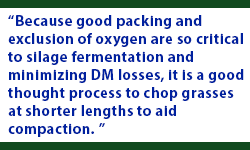
Alfalfa and grass silage chop lengths
 By Wyatt Smith, Vita Plus dairy specialist
By Wyatt Smith, Vita Plus dairy specialistHarvesting and ensiling alfalfa and grass forages is either underway or will be soon, and one topic Vita Plus team members often discuss is the proper theoretical length of cut (TLOC) of these crops. With many producers growing grasses in the place of alfalfa due to winterkill this year, this topic is being discussed more frequently. For this article, we want to discuss forage chop length and the key points to think about when harvesting either legume or grass forages.
We often discuss forage particle size after the harvest and ensiling processes are completed and we are already feeding it to the cows. Although the particle size presented to the cows is an important aspect, we also need to keep in mind the particle size of the forage at ensiling. Particle size at ensiling can influence packing and dry matter (DM) losses, and, with limited forages present on most farms, minimizing DM losses in the bunk is of the utmost importance and will aid in maximizing our true forage inventory.
 As such, the chop length needs to be short enough to reduce the amount of material that will accumulate on the top sieve of the Penn State Particle Separator (PSPS), which will be difficult to pack in the bunker. The goal is to maintain 10% to 15% of the particles on the top sieve (19 mm) in the PSPS. Current TLOC recommendations are 0.5 to 0.75 inches for alfalfa and 0.25 to 0.375 inches for grass silages. The driving factor behind the reduced TLOC for grass silages is the physical form of the grass compared to alfalfa. The hollow tubular structure of the grass stem, especially cereal grasses such as oats and triticale, is more difficult to pack and has more potential to trap unwanted oxygen. Because good packing and exclusion of oxygen are so critical to silage fermentation and minimizing DM losses, it is a good thought process to chop grasses at shorter lengths to aid compaction.
As such, the chop length needs to be short enough to reduce the amount of material that will accumulate on the top sieve of the Penn State Particle Separator (PSPS), which will be difficult to pack in the bunker. The goal is to maintain 10% to 15% of the particles on the top sieve (19 mm) in the PSPS. Current TLOC recommendations are 0.5 to 0.75 inches for alfalfa and 0.25 to 0.375 inches for grass silages. The driving factor behind the reduced TLOC for grass silages is the physical form of the grass compared to alfalfa. The hollow tubular structure of the grass stem, especially cereal grasses such as oats and triticale, is more difficult to pack and has more potential to trap unwanted oxygen. Because good packing and exclusion of oxygen are so critical to silage fermentation and minimizing DM losses, it is a good thought process to chop grasses at shorter lengths to aid compaction.
Of course, these are general recommendations. It is understood that the particle size of the forage will vary due to several variables, including chopper knife sharpness, cutter bar integrity, windrow size and horsepower applied. Because so much mechanical variance surrounds this subject, it will require monitoring and adjustment during the actual harvest process. However, based on recent research with forage particle sizes, we are learning a little shorter chop length has just as many, if not more, benefits as a little longer chop length. For example, reducing excessively long particles from entering the bunker/silo is accompanied by a reduction in long particles presented to the dairy cow, which can reduce sorting behavior in the feedbunk and produce more consistent intakes of the intended diet.
In summary, it is beneficial to adjust the TLOC to be more favorable for the ensiling process. Keep in mind, the particle size of the forage entering the bunk is only one part of the system. It goes without saying that we need to harvest legume and grass forages at the right DM, pack the bunker properly, utilize forage inoculants, and cover the silage in a timely manner.
| Category: |
Feed quality and nutrition Forage Foundations Forage harvesting |

